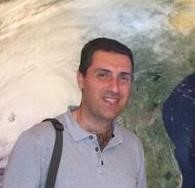Recent relevant publications/patents
1. Stavroulas, G. Grivas, P. Michalopoulos, E. Liakakou, A. Bougiatioti, P. Kalkavouras, K. M. Fameli, N. Hatzianastassiou, N. Mihalopoulos and E. Gerasopoulos, “Field Evaluation of Low-Cost PM Sensors (Purple Air PA-II) Under Variable Urban Air Quality Conditions in Greece”, Atmosphere 2020, 11(9), 926. https://doi.org/10.3390/atmos11090926.
2. N. Hatzianastassiou, E. Ioannidis, M. B. Korras-Carraca, M. Gavrouzou, C. D. Papadimas, C. Matsoukas, N. Benas, A. Fotiadi, M. Wild and I. Vardavas, “Global Dimming and Brightening Features during the First Decade of the 21st Century”, Atmosphere, 11(3), 308, 2020, https://doi.org/10.3390/atmos11030308.
3. D. G Kaskaoutis, G. Grivas, C. Theodosi, M. Tsagkaraki, D. Paraskevopoulou, I. Stavroulas, E. Liakakou, A. Gkikas, N. Hatzianastassiou, C. Wu, E. Gerasopoulos, and N. Mihalopoulos, “Carbonaceous Aerosols in Contrasting Atmospheric Environments in Greek Cities: Evaluation of the EC-tracer Methods for Secondary Organic Carbon Estimation”, Atmosphere 2020, 11(2), 161; https://doi.org/10.3390/atmos11020161, 2020.
4. N. Hatzianastassiou, N. Kalaitzi, M. Gavrouzou, A. Gkikas, M. B. Korras-Carraca, and N. Mihalopoulos, “A Climatological Satellite Assessment of Absorbing Carbonaceous Aerosols on a Global Scale”, Atmosphere, 10(11), 671, 2019.
5. S. Kolios, and N. Hatzianastassiou, “Quantitative dust detection from Meteosat imagery using an Artificial Neural Network Model”, Remote Sensing, 11(9), 1022, 2019; https://doi.org/10.3390/rs11091022.
6. A. Gkikas, N. Hatzianastassiou, N. Mihalopoulos, and O. Torres, "Characterization of aerosol episodes in the greater Mediterranean Sea area from satellite observations", Atmospheric Environment, 128, 286-304, 2016.
7. A. A. Floutsi, M. B. Korras-Carraca, C. Matsoukas, N. Hatzianastassiou, and G. Biskos, "Climatology and trends of aerosol optical depth over the Mediterranean basin during the last 12 years (2002-2014) based on Collection 006 MODIS Aqua Data", The Science of Total Environment, 551-552, 292-303, 2016.
8. G. Athanassiou, N. Hatzianastassiou, A. Gkikas, and C. Papadimas, "Estimating aerosol optical depth over the broader Greek area from MODIS satellite data", Water, Air, & Soil Pollution, 224:1-14, DOI 10.1007/s11270-013-1605-2, 2013.
9. V. Pappas, N. Hatzianastassiou, C. Papadimas, C. Matsoukas, S. Kinne, and I. Vardavas, “Spatio-temporal variability of global AeroCom aerosol optical depth and evaluation against MODIS and CALIOP data”, Atmospheric Chemistry and Physics, 13, 8381–8399, 2013.
10. N. Hatzianastassiou, B.D. Katsoulis, and V. Antakis, "Extreme nitrogen oxide and ozone concentrations in Athens atmosphere in relation to meteorological conditions", Environmental Monitoring and Assessment, 128, 447-464, 2007.
Number of publications, 74 (19-11-2020) Number of citations: >1.700 (Scopus 19-11-2020)
H factor = 24 (Scopus 19-11-2020)
Recent Research projects / grants (last 5 years)
1. The effect of main aerosol types on solar radiation: computations with a detailed spectral radiation transfer model and MERRA-2 aerosol data, Operational Program “Human Resources Development, Education and Lifelong Learning”, 2nd cycle, Axis: “Improvement of effectiveness of the educational system”, Country: Greece, Duration: 2020-2021, Funding: National Strategic Reference Network (NSRF) (2014-2020), European Union
2. Web-based platform for automated early information of the pubic and local authorities about severe weather events, Operational Program “Epirus 2014-2020”, Axis: “Enforcement of regional competition through the development of innovation and information and technology techniques, Country: Greece, Duration: 2019-2022, Funding: National Strategic Reference Network (NSRF) (2014-2020), European Union
3. Panhellenic Infrastructure for atmospheric composition and climate change (PANACEA), Partnership and Cooperation Agreement: Operational Programme "Competitiveness, Entrepreneurship and Innovation 2014-2020 (EPAnEK)", Country: Greece, Duration: 2018-2021, Funding: National Strategic Reference Network (NSRF) (2014-2020), European Union
4. Pollution Alters Natural aerosol composition: Implications for Ocean Productivity, cLimate and air qualitY (PANOPLY), ARISTEIA: Operational Programme "Education and Lifelong Learning", Country: Greece, Duration: 2013-2016, Funding: National Strategic Reference Network (NSRF) (2007-2013), Greek Ministry of Education, Research and Religious Affairs, European Union
5. Identification of sources and physicochemical properties of fine and very fine suspended particles of atmospheric aerosol affecting the climate of Greece, THALES: Reinforcement of the Interdisciplinary and/or inter-institutional research and innovation with the possibility of attracting high standard researchers from abroad through the implementation of basic and applied research of excellence, Country: Greece, Duration: 2012-2015, Funding: National Strategic Reference Network (NSRF) (2007-2013), Greek Ministry of Education, Research and Religious Affairs, European Union
